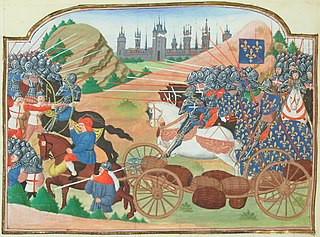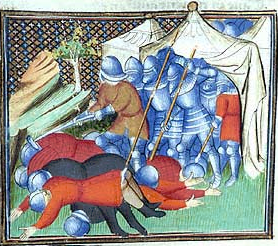 W
WThe Battle of Beaugency took place on 16 and 17 June 1429. It was one of Joan of Arc's battles. Shortly after relieving the siege at Orléans, French forces recaptured the neighboring district along the Loire river. This campaign was the first sustained French offensive in a generation during the Hundred Years' War.
 W
WThe Battle of Cravant was fought on 31 July 1423, during the Hundred Years' War between English and French forces at the village of Cravant in Burgundy, at a bridge and ford on the banks of the river Yonne, a left-bank tributary of the Seine, southeast of Auxerre. The battle ended in a victory for the English and their Burgundian allies.
 W
WThe Battle of Jargeau took place on 11–12 June 1429. It was part of the Loire Campaign during the Hundred Years' War, where Charles VII's forces successfully recaptured much of the region following their victory at the siege of Orleans. The battle ended in victory for Charles VII and is notable as Joan of Arc's first offensive battle.
 W
WThe Battle of Meung-sur-Loire took place on 15 June 1429. It was one of Joan of Arc's battles following relief of the siege at Orléans. This campaign was the second sustained French offensive in a generation in the Hundred Years' War.
 W
WThe Battle of the Herrings, also called the Battle of Rouvray, was a military action near the town of Rouvray in France, just north of Orléans, which took place on 12 February 1429 during the siege of Orléans in the Hundred Years' War. The immediate cause of the battle was an attempt by French and Scottish forces, led by Charles of Bourbon and Sir John Stewart of Darnley, to intercept a supply convoy headed for the English army at Orléans. The English had been laying siege to the city since the previous October. This supply convoy was escorted by an English force under Sir John Fastolf and had been outfitted in Paris, whence it had departed some time earlier. The battle was decisively won by the English.
 W
WThe Battle of Baugé, fought between the English and a Franco-Scots army on 22 March 1421 at Baugé, France, east of Angers, was a major defeat for the English in the Hundred Years' War. The English army was led by the king's brother Thomas, Duke of Clarence, while the Franco-Scots were led by both John Stewart, Earl of Buchan, and Gilbert de Lafayette, the Marshal of France. English strength was 4,000 men, although only 1,500 deployed, against 5,000 French and Scots.
 W
WCharles VI, called the Beloved and later the Mad, was King of France for 42 years, from 1380 until his death in 1422. He is known for his mental illness and psychotic episodes which plagued him throughout his life. Charles's reign would see his army crushed at the Battle of Agincourt, leading to the signing of the Treaty of Troyes, which made his future son-in-law Henry V of England his regent and heir to the throne of France. However, Henry would die shortly before Charles, which gave the House of Valois the chance to continue the fight against the English, leading to their eventual victory and the end of the Hundred Years' War in 1453.
 W
WThe Battle of La Brossinière or Battle of la Gravelle was a battle of the Hundred Years' War on 26 September 1423. It occurred at La Brossinière, between the forces of England and France, shortly after hostilities had resumed, following the battle of Agincourt (1415).
 W
WThe Loire Campaign was a campaign launched by Joan of Arc during the Hundred Years' War. The Loire was cleared of all English and Burgundian troops.
 W
WThe Battle of Patay was the culminating engagement of the Loire Campaign of the Hundred Years' War between the French and English in north-central France. The French cavalry inflicted a severe defeat on the English. Many of the English knights and men-at-arms on horses were able to escape but crippling losses were inflicted on the corps of veteran English longbowmen, which was not reconstituted after the battle. This victory was to the French what Agincourt was to the English. Although credited to Joan of Arc, most of the fighting was done by the vanguard of the French army as English units fled, and the main portions of the French army were unable to catch up to the vanguard as it continued to pursue the English for several miles.
 W
WAfter the lifting of the Siege of Orléans and the decisive French victory at the Battle of Patay, the Anglo-Burgundian threat was ended. Joan of Arc convinced the Dauphin Charles to go to be crowned at Reims. The march though the heart of territory controlled by the hostile Burgundians was successful and would give the throne of the French monarchy to Charles VII, who had been ousted therefrom by the Treaty of Troyes.
 W
WThe Siege of Meaux was fought in 1421-1422 between the English and the French during the Hundred Years' War. The English were led by King Henry V. Henry became ill while fighting this long battle, which took place during the winter months. He died on 31 August as a result.
 W
WThe Siege of Montargis took place during the Hundred Years War. A French relief army under Jean de Dunois routed an English force led by the Earl of Warwick.
 W
WThe Siege of Orléans was the watershed of the Hundred Years' War between France and England. It was the French royal army's first major military victory to follow the crushing defeat at the Battle of Agincourt in 1415, and also the first while Joan of Arc was with the army. The siege took place at the pinnacle of English power during the later stages of the war. The city held strategic and symbolic significance to both sides of the conflict. The consensus among contemporaries was that the English regent, John of Lancaster, would have succeeded in realizing his brother the English king Henry V's dream of conquering all of France if Orléans fell. For half a year the English and their French allies appeared to be winning but the siege collapsed nine days after Joan's arrival.
 W
WThe siege of Paris was an assault undertaken in September 1429 during the Hundred Years' War by the troops of the recently crowned King Charles VII of France, with the notable presence of Joan of Arc, to take the city held by the English and the Burgundians. King Charles's French troops failed to enter Paris, defended by the governor Jean de Villiers de L'Isle-Adam and the provost Simon Morhier, with the support of much of the city's population.
 W
WThe Battle of Verneuil was a strategically important battle of the Hundred Years' War, fought on 17 August 1424 near Verneuil in Normandy and a significant English victory. It was a particularly bloody battle, described by the English as a second Agincourt.